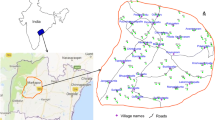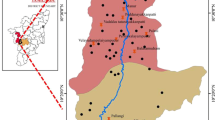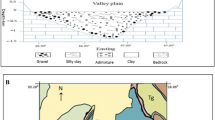Abstract
Groundwater samples were collected from various localities of Mithi sub-district of the Thar Desert of Pakistan and analysed for fluoride ion along with other chemical parameters. The area is mainly covered by sand dunes and kaolin/granite at variable depths. Results showed that collected water samples were severely contaminated by the presence of fluoride ion and most of the samples have higher concentration than prescribed WHO standards (1.5 mg/l) for drinking water. Fluoride ion concentrations ranged between 0.09 and 11.63 mg/l with mean and median values of 3.64 and 3.44 mg/l, respectively, in this area whereas, distribution pattern showed high concentrations in the vicinity of Islamkot and Mithi towns. The content of F− has also been correlated with other major ions found in the groundwater of the study area. The positive correlation of F− with Na+ and HCO3 − showed that the water with high Na+ and HCO3 − stabilizes F− ions in the groundwater of the Thar Desert. The pH versus F− plots signifies high fluoride concentration at higher pH values, implying that alkaline environment favours the replacement of exchangeable OH− with F− in the groundwater of Mithi area. The saturation indices (SI) of fluorite (CaF2) and calcite (CaCO3) in the groundwater samples showed that most of the samples are oversaturated with respect to calcite whereas majority of samples have been found under saturated with respect to fluorite. The log TDS and Na/Na+Ca ratio reflected supremacy of weathering of rocks, which promotes the availability of fluoride ions in the groundwater. Piper diagram has been used to classify the hydrofacies. In the cation triangle, all samples are Na-type, while the anion triangle reflects major dominance of Cl-type with a minor influence of HCO3 − and SO4 −.








Similar content being viewed by others
References
Abbas SG, Atiq M (2005) A brief on coal deposits of Sindh, Pakistan, Sp. Pub. GSP, Pakistan, Karachi, p 27
Apambire WB, Boyle DR, Michel FA (1997) Geochemistry, genesis, and health implications of fluoriferous groundwaters in the upper regions of Ghana. Environ Geol 33(1):13–24
Banks D, Reimann C, Røyset O, Skarphagen H, Sæther OM (1995) Natural concentrations of major and trace elements in some Norwegian bedrock groundwaters. Appl Geochem 10:1–16
Banks D, Frengstad B, Midtgård AK, Krog JR, Strand T (1998) The chemistry of Norwegian groundwaters: I. The distribution of radon, major and minor elements in 1604 crystalline bedrock groundwaters. Appl Geochem 10:1–16
Botha FS, Van Rooy JL (2001) Affordable water resource development in the northern province, South Africa. J Afr Earth Sci 33:687–692
Carrillo-Rivera JJ, Cardona A, Edmunds WM (2002) Use of abstraction regime and knowledge of hydrogeological conditions to control high fluoride concentration in abstracted groundwater: San Luis Potosý´ basin, Mexico. Hydrogeol J 261:24–47
DCR (District Census Report) of Tharparkar District (2000) Population Census Organization, Statistics Division. Government of Pakistan, Islamabad, p 249
Domenico PA, Schwartz FW (1990) Physical and chemical hydrogeology. Wiley, New York
Dowgiallo J (2000) Thermal water prospecting results at Jelenia Go´ra-Cieplice (Sudetes, Poland) versus geothermometric forecasts. Environ Geol 39:433–436
Fassett JE, Durrani NA (1994) Geology and coal resources of the Thar coal field, Sindh Province, Pakistan. US Geol Surv open-file report 94–167, p 74
Frencken JE (editor) (1992) Endemic fluorosis in developing countries, causes, effects and possible solutions. Publication number 91.082, NIPG-TNO, Leiden, The Netherlands
Frengstad B, Banks D, Siewers U (2001) The chemistry of Norwegian groundwaters: IV. The dependence of element concentrations in crystalline bedrock groundwaters. Sci Total Environ 277:101–117
Gibbs RJ (1970) Mechanisms controlling world water chemistry. Science 170:1088–1090
Gizaw B (1996) The origin of high bicarbonate and fluoride concentration in waters of the main Ethiopian rift valley, East African rift system. J Afr Earth Sci 22:391–402
Greenberg E, Joseph J. Connors, David Jenkins (1998) Standard methods for the examination of water and wastewater, 20th edn. American Public Health Association, Washington
Guo H, Wang Y (2005) Geochemical characteristics of shallow groundwater in Datong basin, northwestern China. J Geochem Explor 87:109–120
Guo et al (2006) Geochemical processes controlling the elevated fluoride concentrations in groundwaters of the Taiyuan Basin, Northern China. J Geochem Explor 93(1):1–12
Gupta SK, Deshpande RD, Meetu Agarwal, Raval BR (2005) Origin of high fluoride in groundwater in the North Gujarat-Cambay region, India. Hydrogeol J 13:596–605
Jacks G, Bhattacharya P, Chaudhary V, Singh KP (2005) Controls on the genesis of some high-fluoride groundwater in India. Appl Geochem 20:221–228
Jalil A, Alam GS, Hasan MT (2002) Coal resources of four blocks in Thar coalfield, Sindh, Pakistan, vol 115, record of GSP, 114p
Jan MQ, Laghari A, Khan MA (1997) Petrology of the Nagar Parkar Igneous Complex, Tharparkar, Southeast Sindh. Geol Bull Univ Peshawar 30:227–249
Judy AR (2003) “Fluoride” in encyclopedia of water science. Marcel Dekker, New York
Kundu N, Panigrahi MK, Tripathy S, Munshi S, Powell MA, Hart BR (2001) Geochemical appraisal of fluoride contamination of groundwater in the Nayagarh district of Orrissa India. Environ Geol 41:451–460
Laghari A (2005) Petrology of the Nagar Parkar granites and associated basic rocks, Thar District, Sindh Pakistan. Presented in Fossil fules and mineral resources of Sindh, University of Sindh, Jamshoro, 28 Feb−2 Mar 2005, (abstract), 6p
Mandel S, Shiftan ZL (1980) Groundwater resources investigation and development. Academic Press, New York
Mir M, Naseem S (2005) Thar coal: geology and its potential for power generation, 1st economic Jordanian forum, Mafraq-Jorden, 9–11 Aug 2005, p55
Nordstrom DK, Ball JW, Donahoe RJ, Whittemore D (1989) Groundwater chemistry and water–rock interaction at Stripa. Geochim Cosmochim Acta 53:1727–1740
Parkhurst DL, Appelo CAJ (1999) User’s guide to PHREEQC (version 2)—a computer program for speciation, batch-reaction, one dimensional transport, and inverse geochemical calculations. US Geol Surv, water-resources investigations report, 99–4259
Ploethner D (1992) Groundwater investigations in desert areas of Pakistan: German Federal Institute for Geosciences and Natural Resources report Archives No. 108858 2:84–135
Rafique T (2003) Analytical investigation of groundwater quality of Mithi, Umarkot and Diplo Talukas (Sub-districts) of Thar Desert Pakistan. M. Phil thesis, National Center of Excellence in Analytical Chemistry, University of Sindh, Jamshoro
Rafique T, Bhanger MI, Vasandani AGM (2004) Salinity and drinking water quality problem in the Thar Desert—its health and social impacts on local population. In: Proceedings of the national symposium on social, cultural and environmental impacts of water scarcity in sindh. University of Sindh, Jamshoro, pp 233–238
Rao NS, Devadas DJ (2003) Fluoride incidence in groundwater in an area of Peninsular India. Environ Geol 45:243–251
Rehman MU, Zaigham NA, Nizamani MA, Ahmad M, Huda QU (1993) Coal exploration inTharparkar, Sindh, Pakistan. Geol Surv Pak record no. 95, p 35
Rizvi Y, Ahsan SN, Ali SP, Khan MD (2002) Preliminary petrological studies of basement rocks, Thar Coal Basin and its comparison with Nagar Parkar Massif Complex, Thar Parkar District, Sindh, Pakistan. Geol Surv Pak investigation report no. 714, p 32
Rose AW, Hawkes HE, Webb JS (1979) Geochemistry in mineral exploration, 2nd edn. Academic Press, London, p 657
Shanker R, Thussu JL, Prasad JM (2003) Geothermal studies at Tattapani hot spring area, Sarguja district, central India. Geothermics 16:61–76
Walther JV (2005) Essentials of geochemistry. Jones & Bartlett Pub. P 704
WHO (World Health Organization) (1994) Fluorides and oral health. World Health Organization technical report series 846. World Health Organization, Geneva
Zaigham NA, Ahmad MA (1996) Thar rift and its impact on the coal bearing horizons in the Tharparkar region of south-eastern Pakistan. In: Azmat AK, Qamar UH, Viqar H (eds) Proceedings of second SEGMITE international conference, pp 96–100
Author information
Authors and Affiliations
Corresponding author
Rights and permissions
About this article
Cite this article
Rafique, T., Naseem, S., Bhanger, M.I. et al. Fluoride ion contamination in the groundwater of Mithi sub-district, the Thar Desert, Pakistan. Environ Geol 56, 317–326 (2008). https://doi.org/10.1007/s00254-007-1167-y
Received:
Accepted:
Published:
Issue Date:
DOI: https://doi.org/10.1007/s00254-007-1167-y




